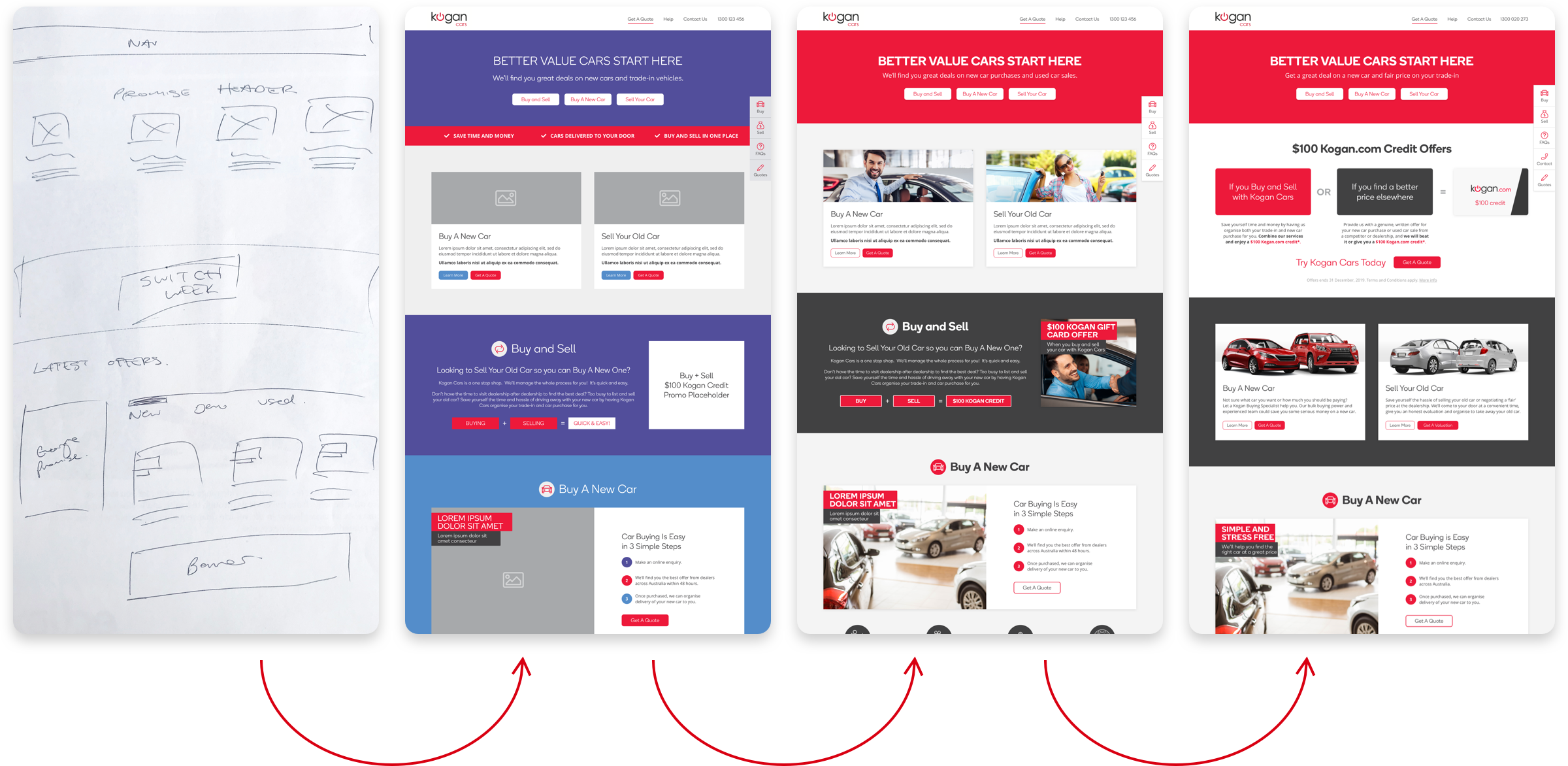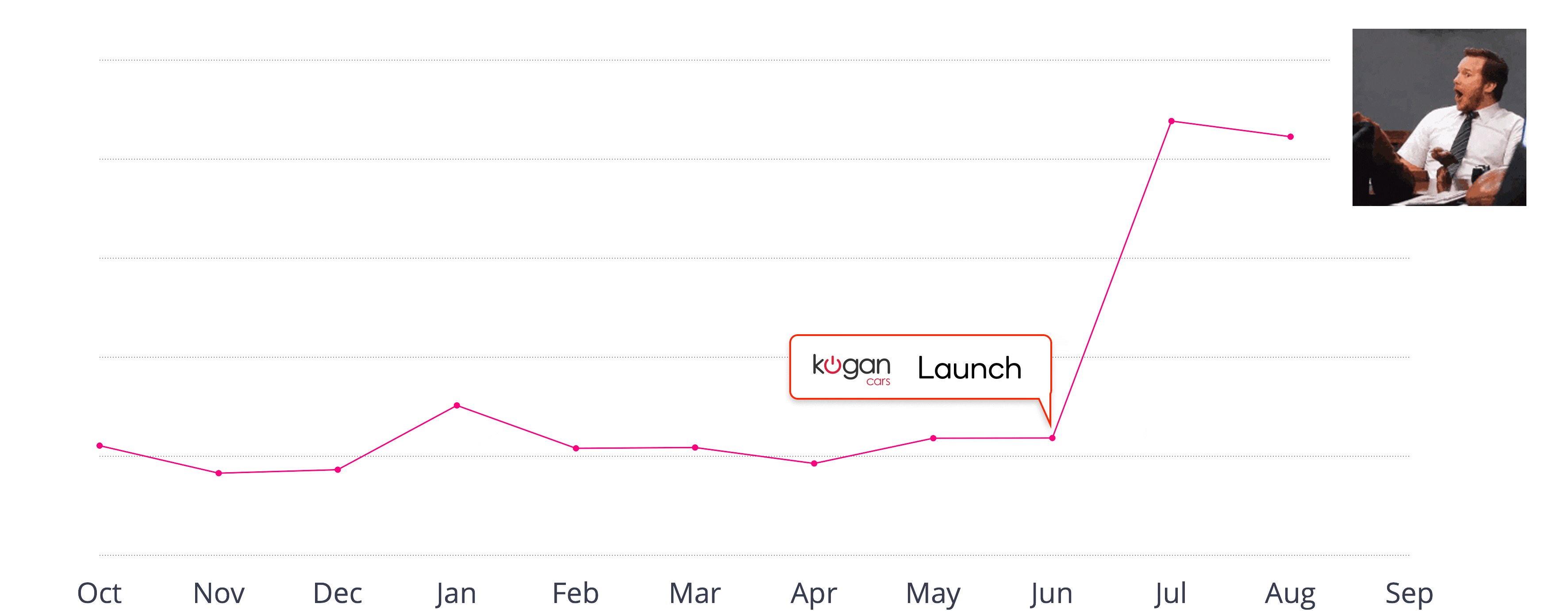kogan cars
A successful partnership which quadrupled lead volume, delivered in 30 days.
A successful partnership which quadrupled lead volume, delivered in 30 days.
Kogan.com is the largest online marketplace in Australia and is focused on making in-demand products and services more affordable and accessible to their consumers. After a rigorous tender bidding process, our team was selected to create a new car buying service to add to their retail and services portfolio.
As the sole creative on this project, I was tasked with the end-to-end design production of Kogan Cars from ideation through discovery, design, testing and deployment phases. I worked cohesively with cross-business teams and suppliers to bring value to our customers, our partners and our business within the extremely tight constraints of our 1 month deadline.
Kogan Cars regularly attracts over 75,000 sessions per month and is regularly optimised to improve the customer experience and efficiency of the service.
Please read below for details on:
Please click here to visit the live website:
View WebsiteProduct Design
Rapid Prototyping
Responsive UI Design
User Acceptance Testing
Digital Advertising
2019 - 2020 at Eclipx Group
I worked side-by-side with these legends:
David Brudenell, Managing Director - Consumer
Angela Goodridge, Group Marketing Manager
Melanie Phelps, Marketing Manager - Georgie
Martin Parry, Chief Developer
Front-End Development: Digilante
Client Stakeholder at Kogan.com
Ross Metherell, Director of Strategy
Kogan.com was expanding its marketplace of products and services offering discounts not ordinarily available to the average Aussie customer, such as Kogan Credit Cards, Kogan Super, Kogan Mobile.
I was involved in the pitching process for Kogan Cars, creating slide decks and presenting potential solutions to the Kogan Strategy team.
Whilst Kogan had the goal of expanding their online portfolio into the vehicle market, we at Georgie had some goals of our own:
Establish strategic partnerships to quickly scale audience and open long term prospect pipelines.
Successfully integrating an existing service to users with different objectives under an extremely short deadline of only 30 days.
After white-boarding numerous design solutions including skinned or iframed content from the existing Georgie website and evaluating the benefits of microsites vs. landing pages for integrating with Kogan's existing marketplace, we decided upon a white-labelled car buying microsite for Kogan's price conscious customers.
The microsite solution was feasible within our timeframe, had high customer impact and was flexible for future growth opportunities.

We needed to adapt our regular working structure because we had stakeholders from 3 separate businesses, our client (Kogan), front-end developers (digital agency, Digilante) and our own team (Eclipx).
Whilst we had a long term agile strategy, to deliver on our 30 day timeline we followed a waterfall methodology to launch our MVP which allowed us to take ownership of specific parts of the project and complete cross-business tasks in a timely manner.
Week 1: Discovery and rapid wire-framing
Week 2: High fidelity prototypes and design
Week 3: Development and go-to-market assets
Week 4: Testing and deployment
Week 5: Retrospection and Phase 2 planning

We utilised existing Georgie customer journeys and sales processes as the foundation for our new service.
We also leveraged existing Kogan personas and their design system as the basis of our UI.
We established clear goals and MVP deliverables early in the process with sign off by all stakeholders.
A mutual stakeholder decision to have cumulative changes post-launch enabled us to move swiftly in the early phases.
Our main priority was clear communication between all stakeholders. Daily WIPs with our internal team, bi-weekly updates with externals, shared Google docs, Slack channels, detailed Invision markups - the aim was to over communicate so no-one or no feature was left behind.
Kogan had detailed information about their customers. The ability to utilise their existing personas and market research for their 12 million active users was one of the key elements to meeting our short deadline.
Kogan customers are savvy, extremely price conscious, bargain hunters and had shown interest in buying cars online if they could be assured they were getting the best price available in the market.
“Car dealerships are absolutely ripe for disruption. Nobody enjoys going there."
“As a young woman, I definitely think it is quite intimidating going into car yards."
“There's a reason car dealers have a bad reputation. They're always trying to swindle you."
Kogan customers had different motivations to our existing Georgie customers as summarised on the table to the right.
Whilst our existing Georgie customers had little prior knowledge of the Georgie brand, customers had high brand awareness of the household Kogan name.
Harnessing the existing credibility of the Kogan brand, we could strip away messaging targeted at building brand recognition and trust on the microsite.
Instead we spotlighted two sales promotions and outlining the ease of the Kogan Cars process to appeal to their savvy disposition.
Kogan customers had different motivations to our existing Georgie customers as summarised on the table below.
Whilst our existing Georgie customers had little prior knowledge of the Georgie brand, customers had high brand awareness of the household Kogan name.
Harnessing the existing credibility of the Kogan brand, we could strip away messaging targeted at building brand recognition and trust on the microsite.
Instead we spotlighted two sales promotions and outlining the ease of the Kogan Cars process to appeal to their savvy disposition.
Brand Awareness
Price sensitivity
Comfort buying online
Primary Age
Primary Gender
Comfort negotiating
Time sensitivity
Low
high
average
high
25-45
30-55
male
female
average
Low
high
average
extremely high
High
We organised all of our discovery learnings into an Affinity Map, allowing us to understand and define the behaviour of our target personas to create our user flows.
With minimal content going into our MVP, the card sorting to define our information architecture was luckily a quick exercise with only four main pages; home, FAQs, contact and submission confirmation pages.
Once happy with our design solution, we used Figma to design and create a clickable prototype using an existing template to expedite the process.
We gave new meaning to rapid prototyping turning around low to high fidelity designs in less than a week.

Although we had little time to test our solution with users, we performA/B tests experimenting with different imagery, layouts and UX writing
These tests were limited to the hero banner and lead form given our time restraints to analyse data and implement changes. Further user testing was to occur following the deployment of our MVP.
We also engaged 4 participants to complete unmoderated usability testing before we launched Kogan Cars.
Although this was a low sample size, we deemed this suitable for this stage of the project to identify core problem areas that needed to be resolved before launch.

Examples of hero banner variants we A/B tested.
My role also extended to go-to-market planning for our business with both online and offline design assets.
Up-skilling our sales team and streamlining our back-stage processes was crucial to our team's experience, which, in turn, allowed them to create a better user experience for our Kogan customers.

With the tap of the 8 million strong Kogan database metaphorically opened in June 2019, car buying leads came flooding in.
Monthly leads increased by over 400% following the launch of Kogan Cars.

Leads per month jumped by an impressive 400%+ following the launch.
“Very slow to respond to your initial query, I've been waiting over a week or two now and haven't received a quote or anything”
“Initial contact was alright, they definitely need to work on customer follow up to ensure all expectations are met.”
“Great service. Process not so smooth… It’s a tense time when purchasing a car and you want to be able to speak to your contact when needed.”
Quantitative and qualitative feedback was overall extremely positive about the Kogan Cars service. The customer experience delivered on our promise of competitive prices for new cars and buyers loved that they could "buy a car from my couch".
However, an increasing amount of customers began complaining about slow response times, primarily by users who were further along their customer journey and close to making a purchase. With four times the leads being generated almost over night, our system needed to change to meet demand.
To better understand how the business could address the needs of this segment of users, we interviewed our sales team on how they could identify these customers so they could be prioritised in the call queue.
Workshops unveiled different solutions including chatbots, employing casual or offshore sales support, extending operating hours, sending progress emails to those in the queue, however we decided upon a more detailed lead form with rules to segment users into sub-groups based on buyer journey stage.
Business processes were adapted as well to prevent staff from taking annual leave during planned Kogan campaign event dates when lead volumes were likely to be much higher.
The addition of extra qualifying questions in our lead form funnelled leads into different stages of the customer journey allowing our sales team to triage leads and contact those very close to purchasing who reported higher stress levels and having more pressing needs, first.
Extra form fields were added as branching questions so only relevant questions were presented to users and the default state of the form appeared less intimidating.
Customers were filtered into different workflows based on their submissions and Hubspot Marketing Automation delivered customised, relevant content to users depending on their stage of the buying journey. For example, if a user was only beginning their vehicle search, they were offered blog article content to help narrow down their options before they spoke to a consultant.

Updated branching form to segment qualified leads.
We resumed a traditional agile practise after the launch of our MVP in July 2019.
Working from feedback from remote user interviews, online questionnaires and analysis from Hot Jar heat maps and A/B tests, we made cumulative changes to the Kogan Cars microsite. All product decisions were cross referenced with the needs of our Kogan personas.
We created landing pages to accommodate Kogan sales campaigns like "Switch Week" and regularly updated our design system for scale, efficiency, and consistency when developing future updates.

We launched Kogan Cars to great success. We achieved our primary objective of quickly scaling our audience and opening long term prospect pipelines whilst integrating the needs of our stakeholders, technical possibilities and business requirements cohesively.
Here are some of our project outcomes:
The microsite has consistently delivered 4x our traditional lead volume - far exceeding the expectations of both our business and our partner, Kogan.com.
The launch of Kogan Cars drew a lot of media attention and free PR opportunities, for example an advertorial on A Current Affair which initiated over 1,000 Kogan Cars enquiries within the first hour of the segment going to air.

A case study of this project became a proof point for future Georgie partnerships highlighting the speed of implementation and conversion success that could be possible with a bespoke integrated white labelled service.
The modular structure of the MVP allowed us to quickly implement new features to the microsite after the launch, like adding new streams for used cars, trade-ins, updated FAQs content, reviews, sales promotions and campaign material.
Kogan affected the way we looked at our wider marketing strategy for parent brand, Georgie. Insights and improvements from the Kogan Cars website were fed back into the Georgie customer experience at a low cost of implementation, for example the triaging lead form.
Together we can turn your highway to hell into a highway to sell.
Jump in my car